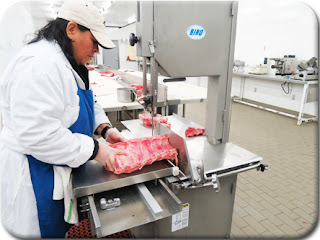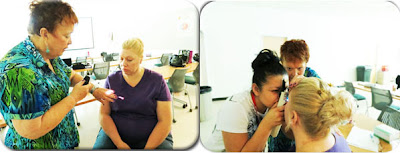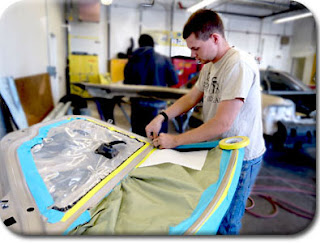Apprentice Meat Cutter
 |
| Packaged retail meats in the Butcher Shop & Deli at Maricopa Skill Center. |
Imagine wearing winter clothes all year-round in Arizona. In fact, none of us would survive especially in the middle of July! But, in the
Meat Cutting Program at
Maricopa Skill Center (MSC), students wear jackets and beanies to keep themselves warm. The average temperature inside the meat cutting room is set at approximately 30-40
ºF to maintain proper sanitation.
 |
| Diagram of Beef Primal Cuts |
MSC's Meat Cutting Program receives domestic orders from vendors, which arrive in large, divided
sections called primal cuts (as shown in the diagram). The students process and handle these primal cuts into individual retail cuts.
Students in the Meat Cutting Program demonstrate proper steps in
preparing beef ribs and beef top sirloin for merchandising a retail meat case and for filling customer orders.
| _____________________________________________________________________ |
|
Beef Ribs
Step 1: A section of the beef rib area is carefully placed under a band saw to slice each piece.
Step 2: After each beef rib is sliced, the piece is examined to see if there is any bone dust, which is removed by a scraper.
Step 3: Any excess fat is trimmed using a 6-inch boning knife.
Step 4: A tray and clear wrap is used to package each beef rib.
Step 5: After the trays are sealed and labeled, they are merchandised in a retail meat case.
_____________________________________________________________________
Beef Top Sirloin
Step 1: Each beef top sirloin is cut into any thickness the customer desires. The knife used to cut this is a 12-inch steak knife.
Step 2: This measuring tool was actually custom-made from the Precision Machining Program at GateWay Community College. It is used to accurately slice the thickness of the meat in different measurements.
Step 3: The beef top sirloin pieces are packaged in a freezer wrapping paper.
Step 4: The packages are then boxed up and ready for customers to pick up.
_____________________________________________________________________
 |
| Butcher Shop & Deli at MSC. |
As you can see, there are interesting steps that goes along processing and handling different types of meats. The next time you're shopping at the grocery store, you'll know exactly what's going on behind the counter in the meat cutting room.
Stay tuned for the next blog spotlight:
Construction Trades!

















































